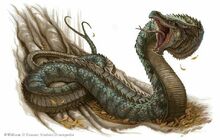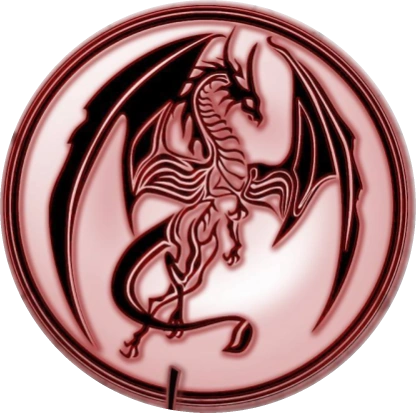No edit summary |
No edit summary Tag: Visual edit |
||
| (17 intermediate revisions by 5 users not shown) | |||
| Line 1: | Line 1: | ||
| + | {{Stub}} |
||
| − | {{Remaai Notice |
||
| + | [[File:C35d2456e3197272474f01d1f0c70a5a.jpg|thumb|220x220px|Artwork of a wyrm from William O'Connor's ''Dracopedia'']] |
||
| − | |What's wrong with this page? = This needs to be reworked and the main page should talk about the dragon in general, rather than the Spiderwick variety. |
||
| + | |||
| − | }} |
||
| + | Wyrms (alternatively wurms, worms or orms) are serpentine dragons, normally of European origins. The word (derived from the Norse 'ormr') used to mean all dragons (or all dragons known in Europe/European dragons), but in modern use it is reserved for dragons with 'wormlike' qualities: a long body shape which is either legless or with small legs. |
||
| − | Wyrms, along with Wyverns, appear in the Spiderwick Chronicles. |
||
| + | |||
| + | Wyrms in Britain include the [[Lambton Worm]] and the Laidly Worm of Bambrough, as well as many more wyrm legends that go by other names: in Sussex, deep pools in the ground are inhabited by wyrms called [[Knucker (Mythology)|knuckers]]. In Wales, the wyrms are called anfanc, and in Scotland they may be called beithir. |
||
| + | |||
| + | 'Wurm' is one of the root words for [[LindWurms (Dragon Species)|lindwurm]] or lindorm, which are dragons found in western and northern Europe: the Bride of the Lindorm King is a popular folktale. The dragon [[Fafnir]] is often described as a lindorm. Historically, 'lindorm' could mean 'all dragons', then 'all serpentine dragons', but in modern use it refers to 'serpentine dragons with two legs' or 'wingless wyverns'. |
||
| − | == Description.== |
||
| − | Wyrms are a four-legged and wingless species that seem to originate from England. They are mainly aquatic, living wherever there is water. Wyrms are extremely powerful and seem to live a very long time if not slain. They bear a resemblance to the [[Knucker (Dragonology)|Knucker]]. |
||
[[de:Draconidae_(Spiderwick)]] |
[[de:Draconidae_(Spiderwick)]] |
||
[[Category:Mythology]] |
[[Category:Mythology]] |
||
| + | [[Category:Dragon Species]] |
||
| + | [[Category:Wyrms]] |
||
| + | [[Category:Mythological Animals]] |
||
Revision as of 19:44, 11 October 2021

Artwork of a wyrm from William O'Connor's Dracopedia
Wyrms (alternatively wurms, worms or orms) are serpentine dragons, normally of European origins. The word (derived from the Norse 'ormr') used to mean all dragons (or all dragons known in Europe/European dragons), but in modern use it is reserved for dragons with 'wormlike' qualities: a long body shape which is either legless or with small legs.
Wyrms in Britain include the Lambton Worm and the Laidly Worm of Bambrough, as well as many more wyrm legends that go by other names: in Sussex, deep pools in the ground are inhabited by wyrms called knuckers. In Wales, the wyrms are called anfanc, and in Scotland they may be called beithir.
'Wurm' is one of the root words for lindwurm or lindorm, which are dragons found in western and northern Europe: the Bride of the Lindorm King is a popular folktale. The dragon Fafnir is often described as a lindorm. Historically, 'lindorm' could mean 'all dragons', then 'all serpentine dragons', but in modern use it refers to 'serpentine dragons with two legs' or 'wingless wyverns'.
